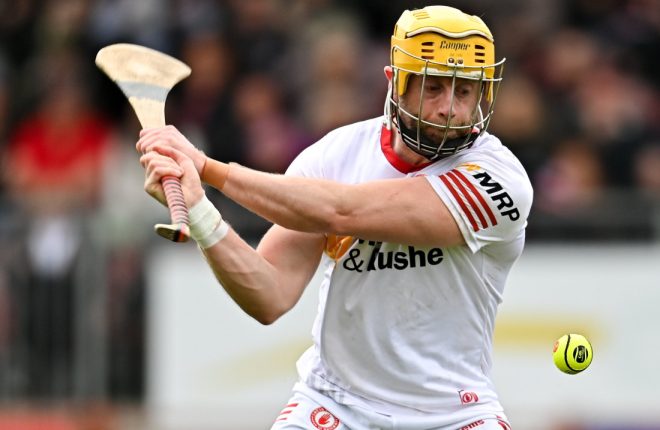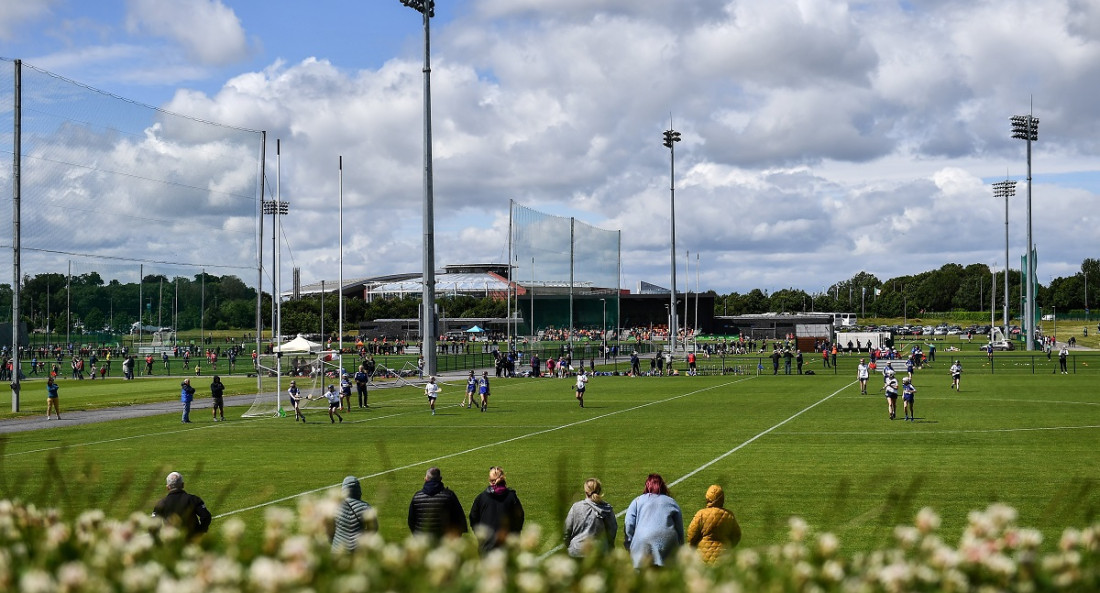The race for the Liam McCarthy Cup has been a club of too few counties. Michael McMullan got the thoughts of some of those involved in hurling outside the elite on how to start closing the gap.
WITH just four teams left in the race to put their ribbons on the Liam McCarthy Cup, Ulster’s interest in the 2023 inter-county hurling scene has long since gone.
Monaghan made history by annexing a first ever Lory Meagher Cup. Antrim secured their much-needed Division One status.
Down stayed in Division 2A by virtue of score difference ahead of a Derry team who came very close in their bid to get hands on the Christy Ring Cup.
At the top end, hurling is super healthy. The Munster giants rolled out rollercoaster after rollercoaster. Kilkenny did what Kilkenny do, they found a way of winning in Leinster, hitting Galway with the sucker-punch that was Cillian Buckley’s winning goal.
As recently as Saturday, Galway threw their hat back in the All-Ireland race. With the finish line in sight against Tipperary, they held on this time.
At the weekend, the young hurlers of Middletown, Banagher and Kevin Lynch’s were among the winners in the All-Ireland Féile competition.
That’s the grassroots. The concern is how far away the rest of the counties are at inter-county level.
Andrew Kilcullen is one of the players hurling outside of the top flight with Sligo.
“I think the tiered system we have at the moment, the Meagher, Rackard, Christy Ring Cups, are brilliant for the promotion of hurling in the weaker counties,” he commented of the championship scene below the Liam McCarthy.
The scene of the winning Monaghan team carrying the Lory Meagher Cup into the county shows exactly what it means.
Tyrone hurlers were mixing in the Christy Ring Cup and Seán Óg Grogan is aware of the influence these games can have. Hosting championship games in Carrickmore and Dungannon let the kids see what is there for them.
It’s all well and good, but checking for hurling’s pulse across the land will surely ask the question of how a bridge can be built from the Limericks and Kilkennys across to the rest.
Offaly have got their house in order. Carlow are the same. Westmeath turned over Wexford.
It’s progress, but it’s only shoots. Over the last decade, only ten teams played in the quarter-finals – or further – in the All-Ireland Senior Championship. Of that, Laois were there once, in 2019. Wexford have been in the latter stages’ shakeup five times. Only six counties have made a final.
If those serious about hurling get a chance to brainstorm – a proper dig – what would they see?
Someone who knows too well is Down manager Ronan Sheehan. After putting his lot with the county underage teams, he stepped into the role as senior manager while still hurling at club level with Newry Shamrocks. Just last week, he was lending a hand with the county’s underage camogie squad.
If a countrywide hurling think-tank were to get together, what are the first avenues of progress?
“Number one is fixtures and guaranteed weeks or days for hurling,” Sheehan offers. “There is no point in putting money into schools etc when as soon as lads get to u-14 they stop as football club training is three nights a week.”
There is no space to play hurling games, never mind train.
“The biggest issue for hurling is space in the calendar,” he adds. “Club football is the biggest issue as underage managers think they are Mickey Harte and want to train every night of the week, so where is the space for hurling?”
Last weekend, Lavey camogs were in the All-Ireland Féile competition and they will be in the football All-Ireland this weekend.
In a recent Gaelic Life feature, the club spoke of compromise and ensuring both codes could operate side by side. Ladies football has only started within the last six years and one of the areas of focus at the start was making sure it wouldn’t step on camogie toes.
There is the story of Sleacht Néill where their senior hurling and football teams were intertwined in a decade of unparalleled success.
Sheehan has a solution for allowing hurling to grow into the fabric of the club scene. To properly grow, rather just a cramming session.
“What needs to happen is like in Dublin, where the games are played one week hurling and the next football,” he said.
“Yep, that will mean some lads sitting with no game every two weeks but that will encourage them to take up the other code.”
Another variant would see certain months dedicated to hurling. Many want to throw a blank cheque at the problem. For Sheehan, fixture space is “just as critical” as any funding drives.
While Sheehan can see a higher standard of hurler emerging, the gap is not closing. There needs to be more dialogue and thought before allocating funds.
“There is only so much money available,” he points before throwing questions that need looked into.
Do we need more clubs? Is it a case of focussing on the “stronger clubs” and raising the standard there?
“There are a lot of questions and debate needed before we even think about throwing more money at it,” he concluded.
***
Seán Óg Grogan also feels fixtures have a central part to play in any plan for the growth of hurling, but getting coaches into the grassroots is also very important.
As a hurler with Tyrone, he would welcome any national plan for the game but can only view it through Ulster glasses for now.
Hurling in Ulster needs backed. Financially, yes, but there has to be a plan. In five years’ time, he doesn’t want to look back on what money has been allocated. It’s more than that.
“We need proper hurling development officers and this isn’t a job for one person,” he said.
“They need to get them into the counties. In Tyrone, we have one hurling coach that goes around schools. That’s a tick box.
“They need to get these roles with a decent salary and the correct people in them… and get the structures in place.”
Grogan uses the Dublin example and how well the money was used. They’ve gone from not being in the Liam McCarthy mix in the nineties to making at least the quarter-final stage four times since 2014.
“Albeit they haven’t won one, but they are a Liam McCarthy standard team,” Grogan said.

DIFFERENT APPROACH…Tyrone star Seán Óg Grogan feels a reshuffled club scene would help hurling development
“They put the correct structures in place at underage. They are seeing the benefits of that.
“I am not saying the structures must be the same in every county. They really need to sit down with each county in Ulster and ask how can we work this and how can we grow the game.”
For Grogan, it’s not about hosting a blitz and tweeting a photo about hundreds of kids playing hurling. It needs flesh on the bones and he uses his own club, Éire Óg Carrickmore, as an example of progress.
“We have our first group of u-17s who have been hurling at underage in Derry where there is more competition and more clubs,” he outlines.
“For years, it was a better standard but now our lads are playing in the minor hurling league in Derry and holding their own because most of them have been exposed to it since they were eight, nine or ten years of age.”
Geographically, it’s challenging but players just want to play and they’ll travel.
Speaking on the GAA Social podcast, Terence ‘Sambo’ McNaughton suggested that any long-term plan for hurling would involve building centres around the country for counties to unite and play the game. Grogan offers a similar approach in Ulster.
“There could be some hubs or development centres or something put in place where these lads can go and hurl,” he said.
“Nobody has any issue with travelling, children love getting away to play. This has to be done.”
He hails the progress of the underage Tain Óg league, a competition to give hurlers access to games against clubs across Ulster. It has been run better this year than ever and that needs to continue.
Just like Ronan Sheehan’s thoughts on fixtures helping hurling, Grogan speaks from his experience at club level of the need for more games at the highest standard possible.
Without knowing the ins and outs of how it would be fully rolled out, he floats the idea of an Ulster hurling league that could lead into the championship.
“I know Antrim have a great championship and they don’t want it diluted and I can understand that,” Grogan said.
“In Derry, Sleacht Néill have ten in a row. Kevin Lynch’s are coming close but I don’t think it is doing anybody any good. They play in Derry and are straight into an Ulster final.”
It’s the same in Carrickmore. They had ding-dong games in their county final, followed by battles with Lisbellaw and Middletown in Ulster. But it’s not enough.
“We’ll not have it until a county final this year in October and that’s nearly a full year before a club team is playing at that standard again.”
Grogan’s solution would be a round-robin club series. He looks at what it has done for Munster at inter-county level and youngsters in Tyrone seeing the county senior team play week in and week out in the Christy Ring Cup.
“They have their own championship, they come out of it and are exposed to more competitive games,” he adds of the benefits a new-look Ulster format could bring.
“The example of the team that goes up into senior, they get one game and are knocked out.
“What if you are up into senior and get three games at senior level. It is a help.
“The more games you get there, then you adjust. It would be like Munster at county level, week on week and exposed to high level games.
“Underage players seeing their seniors away to play in the Ulster championship, whether that’s right or wrong, that’s just my thoughts on it.”
***
The players’ views…
WE asked a few current players for their thoughts on the important points any new-look nationwide hurling development plan should be rolling out to spread the game.
“I’d like to see a number of coaches going into coach hurling in our primary schools. At the minute, we have volunteer coaches going in from our club. It was had a coach that was split a day every week into our four or five feeder primary schools all year round.”
– Danny Cullen (Setanta, Donegal)
“I’d say the most important thing is getting the hurling into the national schools so children are starting hurling from an early age. It’s also important to get good hurling promotional officers in every county. Here in Sligo, and I’m sure it’s the same in other counties, football is the main priority and hurling probably isn’t given the respect it deserves. In saying that, hurling in Sligo is growing massively in recent years but it can definitely grow more in my opinion.”
– Andrew Kilcullen (Easkey, Sligo)
“The two points I feel are the most important for a national hurling task force cover different angles.
“I feel there needs to an increase in both development coach numbers and player participation within schools across Ulster and in Belfast.
“Also, there needs to be greater coverage and promotion of the hurling championship competitions outside of the Liam McCarthy Cup.”
– Conor McCann (Creggan, Antrim)
“I’d say two important things is the funding to the so called ‘weaker counties’ and then promoting our competitions through showing highlights and coverage on podcasts.
“I know from taking the Lory Meagher trophy around Monaghan that kids are buzzing now about hurling but that’s just because they see it.
“They need to be exposed to it more on the likes of TV in order to further promote the game in a football strong county like Monaghan.”
– Niall Garland (Castleblayney, Monaghan)
“Firstly, it’s important to increase participation in predominantly football areas. If you speak to a lot of football people, they’re in awe of some of the hurling games they’ll watch in the Munster, Leinster or AlI-Ireland Championship yet so few of them have any interest in playing.
“Mainly just because there’s no real tradition of it in their area. Serious investment in schools and clubs is the only way to change this.”
“Secondly, promotion of the lower tier inter-county championships needs drastic improvement. There has probably been more promotion of the Tailteann Cup in the last couple of years than there has been since the introduction of the lower tier hurling championships nearly 20 years ago.
“A lot of people hardly realise hurling is played outside the top 10 counties. Better promotion of these extremely competitive championships can only result in more interest in so called weaker counties and as a result inspires participation in future generations.”
– Donal Hughes (Bredagh, Down)
“It definitely needs more coaches in the schools, for more children to be exposed to hurling if we are hoping to grow the game.
“You can see what Dublin did with the football in the past 20 odd years and also with getting their hurling up to Liam McCarthy level. It shows you what you can do with money behind and structures in place.”
“There needs to be better promotion of the games at all levels. You see the Tailteann Cup is on before the All-Ireland football semi-final. In hurling, if the finals of the Ring, Rackard and Meagher Cups were spread out and played in front of the All-Ireland hurling semi-finals, it would bring a bigger crowd in than playing in a half-empty stadium.
“Also there needs to be an overall Director of Hurling to oversee the growth the game, with people working under them in Ulster, Connacht and Leinster to give those provinces a hand to grow.”
– Paudie Lappin (Middletown, Armagh)
Receive quality journalism wherever you are, on any device. Keep up to date from the comfort of your own home with a digital subscription.
Any time | Any place | Anywhere













